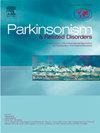帕金森病的身体成分和静息代谢率:一项前瞻性横断面单中心研究
IF 3.4
3区 医学
Q2 CLINICAL NEUROLOGY
引用次数: 0
摘要
帕金森病(PD)的身体成分改变是一种常见但尚未充分了解的表现,具有重要的临床和预后意义。静止代谢率(RMR)在PD的姿势不稳定和步态困难亚型中较高。目的研究PD患者的体成分和RMR,并与健康对照和运动亚型进行比较。方法:本研究报告了一项来自印度三级保健中心的392名PD患者和137名健康对照者的前瞻性研究的中期分析。进行了详细的临床评估,包括使用基于生物电阻抗的身体成分监测仪测量身体成分。结果患者平均发病年龄为48.4±11.7岁,平均病程为6.0±4.1岁。12.8%的患者体重减轻。与对照组相比,PD患者的体重(63.4 vs 70.6 kg)、BMI (24.4 vs 27.5 kg/m2)、内脏脂肪百分比(9.8% vs 12.3%)和腹围(92.8 vs 94.8 cm)明显较低,骨骼肌百分比较高(26.3% vs 25.3%)。运动障碍患者的RMR较低。BMI和内脏脂肪与病程呈负相关。结论PD患者较低的体重、脂肪百分比和较高的骨骼肌百分比可归因于负能量平衡导致的脂肪减少。这一发现与PD中肌肉减少性肥胖的概念相矛盾。运动障碍患者较低的RMR可能归因于更严重的低体重疾病。这些发现促使我们在更大的人群中进行进一步的研究,以更好地理解。本文章由计算机程序翻译,如有差异,请以英文原文为准。
Body composition and resting metabolic rate in Parkinson's disease: A prospective cross-sectional single centre study
Introduction
Altered body composition in Parkinson's disease (PD) is a frequent but inadequately understood manifestation with significant clinical and prognostic implications. Resting metabolic rate (RMR) is found to be higher in the postural-instability and gait-difficulty subtype of PD.
Objectives
To study the body composition and RMR in patients with PD and to compare with healthy controls and among motor subtypes.
Methods
This study reports an interim analysis of a prospective study of 392 patients with PD and 137 healthy controls from a tertiary care center in India. Detailed clinical evaluation was performed, including body composition measurements using bioelectric impedance based body composition monitor.
Results
The mean age at onset and duration of illness were 48.4 ± 11.7 and 6.0 ± 4.1 years, respectively. Weight loss was reported in 12.8 % of patients. Compared to controls, PD patients had significantly lower body weight (63.4 vs 70.6 kg), BMI (24.4 vs 27.5 kg/m2), visceral fat percentage (9.8 % vs 12.3 %), and abdominal girth (92.8 vs 94.8 cm), with higher skeletal muscle percentage (26.3 % vs 25.3 %). RMR was lower in patients with dyskinesia. BMI and visceral fat negatively correlated with disease duration.
Conclusions
The lower body weight, fat percentage, and higher skeletal muscle percentage in PD can be attributed to a negative energy balance resulting in fat loss. This finding contradicts the concept of sarcopenic obesity in PD. Lower RMR in patients with dyskinesia could be attributed to more severe disease with low body weight. These findings prompt further studies with a larger cohort for better understanding.
求助全文
通过发布文献求助,成功后即可免费获取论文全文。
去求助
来源期刊

Parkinsonism & related disorders
医学-临床神经学
CiteScore
6.20
自引率
4.90%
发文量
292
审稿时长
39 days
期刊介绍:
Parkinsonism & Related Disorders publishes the results of basic and clinical research contributing to the understanding, diagnosis and treatment of all neurodegenerative syndromes in which Parkinsonism, Essential Tremor or related movement disorders may be a feature. Regular features will include: Review Articles, Point of View articles, Full-length Articles, Short Communications, Case Reports and Letter to the Editor.
 求助内容:
求助内容: 应助结果提醒方式:
应助结果提醒方式:


